Well, I must admit that Google Translate completely failed me here, and thus I have no real idea what the trick is to this beautiful, stunning transparent split keyboard by [illness072]. Allegedly, the older tweets (exes?) hold the key to this magic, but again, Google Translate.
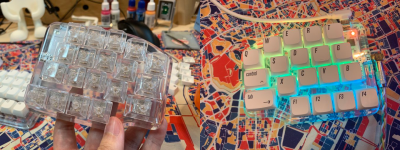 Based on top picture, I assume that the answer lies in something like thin white PCB fingers bent to accommodate the row stagger and hiding cleverly behind the keys.
Based on top picture, I assume that the answer lies in something like thin white PCB fingers bent to accommodate the row stagger and hiding cleverly behind the keys.
Anyone who can read what I assume is Japanese, please advise what is going on in the comments below.
Typewriter-Assisted Philosophy Inspires Art Students
For Sheryl Oring, newly-appointed Dean at UArts School of Arts in Philadelphia, a keyboard isn’t just a tool of expression for the user. It’s a window into hard truths spoken by anyone who happens to be inspired by the vintage red Royal typewriter Sheryl that likes to set up in public places.
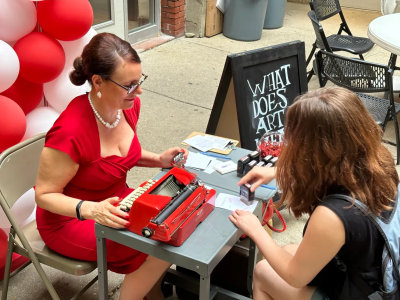
In 2004, Sheryl started a project called I Wish To Say where she invites people to dictate messages to the sitting President. She types them onto 3×5 index cards and keeps a copy for her archives.
The originals she has sent to four United States presidents, urging them to do things such as take notice of the rise in bullying, stop signing things they don’t read, and provide free and effective birth control. Since the beginning, Sheryl has typed 4,300 postcards in dozens of locations across the country.
At a recent student orientation barbecue, Sheryl once again donned the 1960s secretarial get-up and set up her red Royal on (I can only assume) the quad, inviting incoming students to immortalize their answer to the question, “what does art mean to you?” Though the display may have started as a clacking curiosity, the typewriter setup inspired the students to really think about why they were there.
Sheryl typed out the answers as usual, then invited the students to sign their cards and embellish them with various stamps, including the date. Once complete, the cards were hung up for all to see. Some answers were sarcastic, and some profound, but all of them were honest.
The Centerfold: This ‘Lil Busy Box Macro Pad
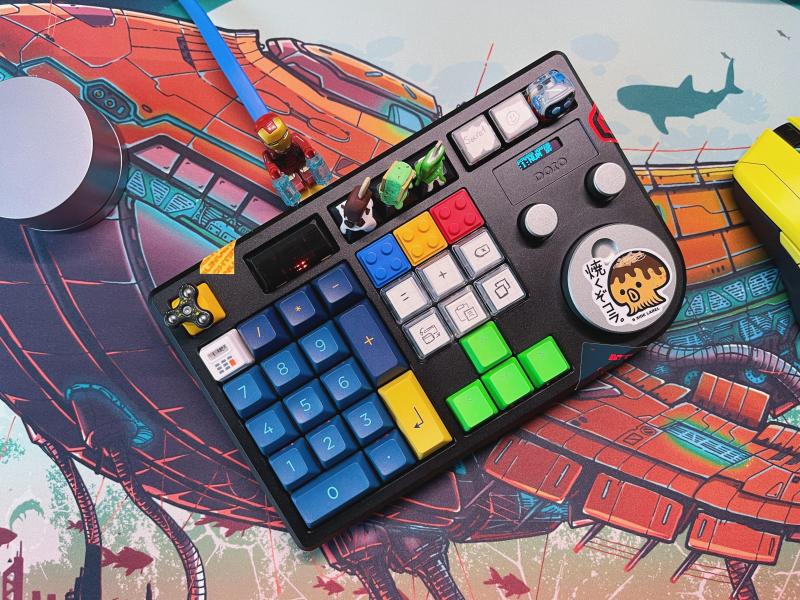 In addition to clear everything, I sure love a good display of primary colors, or a harlequin arrangement if you will. (Remember the Volkswagen Harlequin?)
In addition to clear everything, I sure love a good display of primary colors, or a harlequin arrangement if you will. (Remember the Volkswagen Harlequin?)
This likely DOIO macro pad-inspired project comes from [theglimy], who didn’t provide a lot of detail in the reddit thread (read: basically none whatsoever), but who did craft those lovely ice cream keycaps out of polymer clay. That’s a sick close-up shot of the keycaps. You should click that.
Those novelties stand in stark contrast to the handwritten labels that are just a LEGO keycap away, but that’s okay. I kind like dichotomies when it comes to my centerfolds.
Do you rock a sweet set of peripherals on a screamin’ desk pad? Send me a picture along with your handle and all the gory details, and you could be featured here!
Historical Clackers: the Hamilton Automatic
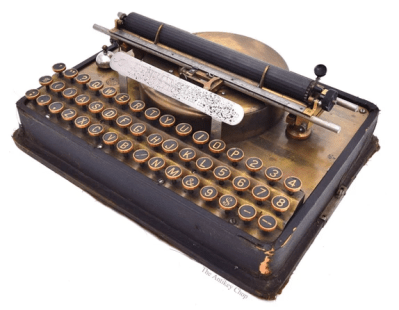
When the average person thinks of typewriters from the late 1880s (as I’m sure they so often do), they probably picture a large, heavy, perhaps cast iron monstrosity that is anything but portable.
Well, let me introduce the smallest typebar typewriter ever produced, the Hamilton Automatic (PDF). It is 9″ x 12″ and weighs 12 pounds. As you can see, it’s the epitome of steampunk, with all that brass everywhere. It sold for $65 beginning in 1887, which is over $2,000 today. However, other typewriters were going for $100 at the time.
The first thing one might notice is the apparent lack of space bar. See that shiny tongue-depressor where the numbers should probably be? That’s the space bar.
Adding to this horrible inconvenience is the fact that this, among many typewriters of its time, is a ‘blind writer’, meaning that the type bars strike the underside of the platen, and the user can’t see what they’ve typed until they scroll up the paper. Loading the paper was even more of a pain that usual because of the design. Furthermore, it wasn’t for everyone — the Hamilton Automatic only typed capitals, some figures, and numerals. There isn’t even a number one; the user has to use I, presumably.
However, the Hamilton Automatic is not without some cool features. It was the first typewriter with proportional character spacing, meaning that the carriage advances depending on the width of the character. Additionally, the machine had a locking plate that prevented adjacent keys from both striking and thus getting stuck.
This typewriter ultimately failed by 1891, probably because of the location of the space bar and the fact that it only typed in uppercase characters. Still, it’s a pretty darn cool piece of history.
ICYMI: TypeBoy and TypePak Are Inseparable
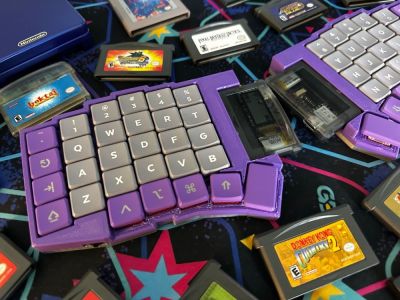 In the world of keyboards, there is tactile, and then there’s tactile. TypeBoy is the latter.
In the world of keyboards, there is tactile, and then there’s tactile. TypeBoy is the latter.
See, it just won’t work without slotting in a pair of aftermarket Game Boy Advance cartridges to the inner sides. Yeah, that’s right. It’s because the microcontroller stack is in there.
Inside each cartridge is a XIAO BLE microcontroller, a Sharp Memory Display, a shift register, and a LiPo battery. If this particular shade of purple doesn’t inspire some early aughts GBA nostalgia, then surely the thumb wheels will.
This is really quite the project, and you can learn all about it on [Stu]’s blog. If you can’t live without your own TypeBoy and TypePak, the files are available on GitHub.
Got a hot tip that has like, anything to do with keyboards? Help me out by sending in a link or two. Don’t want all the Hackaday scribes to see it? Feel free to email me directly.

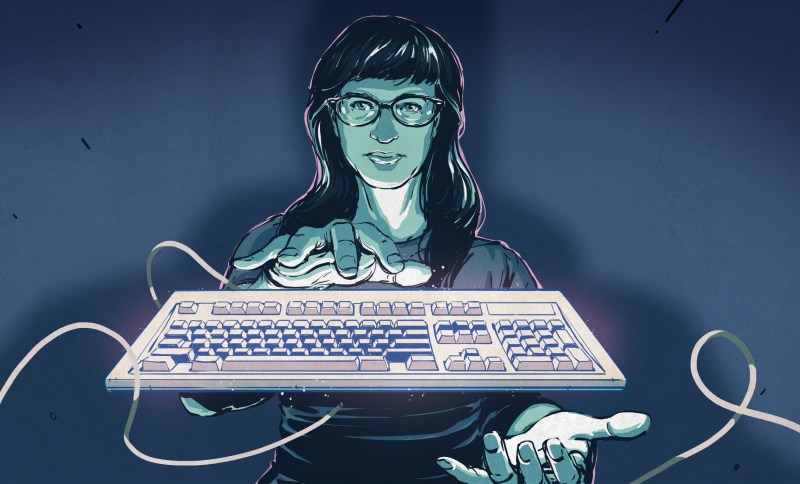















“Furthermore, it wasn’t for everyone — the Hamilton Automatic only typed capitals, some figures, and numerals. There isn’t even a number one; the user has to use I, presumably.” I see that the number 0 is also not present. I presume that one had to use the letter O instead.
For programmers of the day, this probably wasn’t a big deal: http://bears.ece.ucsb.edu/pics/dilbert.gif
Maybe that is where the term ‘computer IO’ got its origins – not from the activity, but the content!
(Chuckle!)
Lots of early typewriters skipped the ‘1’ key and used ‘I’ instead – do an image search on “vintage typewriter” and you’ll find plenty of examples, some surprisingly recent.
[theglimy]’s macropad is more than inspired by DOIO considering it is a DOIO KB30-01
I think this tweet shows the magic behind the transparent keyboard’s wire routing – a very custom board outline layer that connects the dots between individual keys’ footprints.
https://twitter.com/illness072/status/1685639384547336194
As Kristina guessed, the postings of [illness072] are in Japanese. In an earlier post (https://twitter.com/illness072/status/1690889099555860480), かわいいちゃん (kawaii-chan, or cute kid) [illness072] posted (via Google Translate): “And the big favorite, Spica-chan case! Look at this shiny and see-through finish. This is why wenext is recommended!” Wenext (https://www.wenext.com/) is a manufacturing, 3D printing, and CNC Machining service. One of the 3D printing capabilities they offer is SLA and one of the resins they use is Somos® WaterShed XC 11122 (https://www.stratasys.com/en/materials/materials-catalog/stereolithography-materials/somos-watershed-xc-11122/), which appears to allow fantastically clear prints. I’m not familiar with the Spica case but the water-clear look is very nice. I wonder how it will respond to use over time.
Exes. Nicely played.